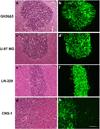Novel cryo-imaging of the glioma tumor microenvironment reveals migration and dispersal pathways in vivid three-dimensional detail
- PMID: 21862632
- PMCID: PMC3173511
- DOI: 10.1158/0008-5472.CAN-11-1553
Novel cryo-imaging of the glioma tumor microenvironment reveals migration and dispersal pathways in vivid three-dimensional detail
Abstract
Traditional methods of imaging cell migration in the tumor microenvironment include serial sections of xenografts and standard histologic stains. Current molecular imaging techniques suffer from low resolution and difficulty in imaging through the skull. Here we show how computer algorithms can be used to reconstruct images from tissue sections obtained from mouse xenograft models of human glioma and can be rendered into three-dimensional images offering exquisite anatomic detail of tumor cell dispersal. Our findings identify human LN-229 and rodent CNS-1 glioma cells as valid systems to study the highly dispersive nature of glioma tumor cells along blood vessels and white matter tracts in vivo. This novel cryo-imaging technique provides a valuable tool to evaluate therapeutic interventions targeted at limiting tumor cell invasion and dispersal.
©2011 AACR.
Conflict of interest statement
Figures






References
-
- Burger PC, Scheithauer BW, Vogel FS. Surgical pathology of the nervous system and its coverings. 3rd ed. New York: Wiley; 2002.
-
- Brat DJ, Castellano-Sanchez AA, Hunter SB, Pecot M, Cohen C, Hammond EH, et al. Pseudopalisades in glioblastoma are hypoxic, express extracellular matrix proteases, and are formed by an actively migrating cell population. Cancer Res. 2004;64:920–927. - PubMed
-
- Scherer HJ. Structural development in gliomas. Am J Cancer. 1938;34:333–348.
Publication types
MeSH terms
Grants and funding
LinkOut - more resources
Full Text Sources
Other Literature Sources
Medical

